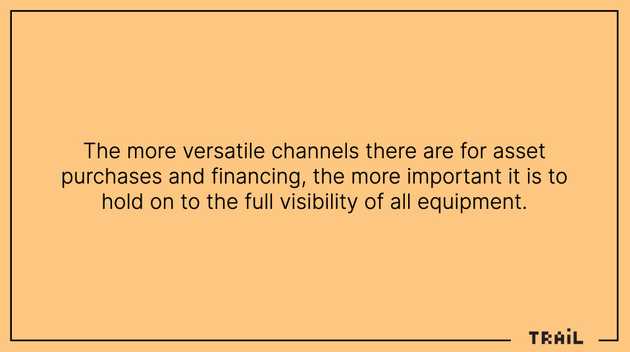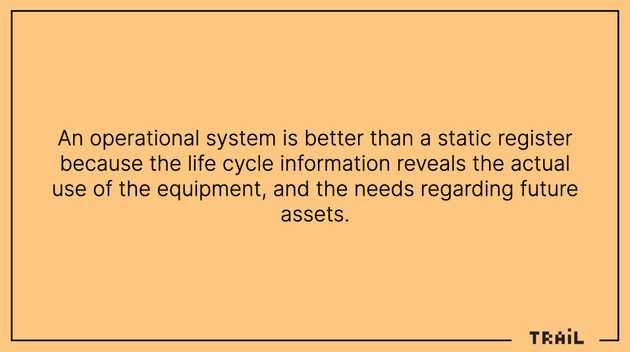Key tool when equipment is sourced from multiple channels
There are a number of channels to acquire equipment for your business. The financing of equipment purchases can also be managed in several different ways. For example, large quantities of equipment are often acquired through leasing instead of buying - outcome being that organizations often manage equipment with several owners.
A flexible solution to hold on to a good view is a operational equipment management system. The advantage of an equipment management system is that ignores how the equipment has been acquired or how the financing of the acquisition has been arranged. Equipment management system focuses only on the equipment in use, its life cycle and efficiency information.
In addition to efficiency, modern equipment management system results in cost savings and smarter investments. The operational system ensures that unnecessary equipment, and the associated costs can be removed. The system also makes efficient use of the equipment that the organization already has.
Achievable benefits:
- Cost savings
- Smarter investments
- Equipment efficiency
- Getting rid of unnecessary equipment
- Full visibility to all equipment
- Independency from equipment suppliers
The importance of equipment management when there are several owners for the equipment
A proper equipment management system provides the a tool that doesn’t care how or where the equipment is sourced. Equipment management focuses on optimizing the life cycle of the asset and it's productivity, regardless of the equipment type in question or how it was acquired. The equipment management system also allows adding and removing equipment so that the status of the equipment is constantly realistic.
The reason why it is imperative that the life cycle of equipment is also monitored through an operational system is that only through active monitoring is it possible to verify the actual use of the equipment and with that the actual need for the asset.
For an organization a significant benefit of a separate equipment system is also the independency of equipment suppliers. An independent system can help to maintain a full visibility to all equipment.
When a system is used to tracks equipment, its use, reservations, returns, breakages and maintenance, the use rate of each asset is well known. Through tracking, it is possible to identify bottlenecks in operations, as well as to notice if any equipment is left completely unused. Proper tracking helps to optimize the amount of assets and ensures that there are no excessive asset investment made in the future.
The system also offers the possibility to monitor the life cycle costs of the equipment and to compare, for example, the total costs of ownership and financing over the life cycle. This will make life easier for decision makers because in the future it will be possible to make decisions based on system data.
The challenge of several asset registers
When equipment is sourced from several channels, it's possible to end up in a situation where there are several asset registers. In such a scenario, it's challenging to upkeep a full view of all equipment. Often the registers consist mostly of a static view to the equipment, but rarely operational support. If a realistic and up-to-date view is needed, it has to be ensured that changes are also reflected in the asset register.
In the above scenario, a smart solution it so ensure a full view with an operational asset register, where all changes are registered already at the time of the change. In modern equipment management systems there are open API interfaces so it's actually possible to gather asset information easily from several sources.
Asset register is practically a list of all equipment. Regardelss of how comprehensive it is, it is still only a list. The critical difference to an operational system comes from operating equipment, and gathering the life cycle information of the equipment. Gathering timely data is easily done with asset labels and mobile app. This is how to ensure that life cycle information is stored already at the origin.
What to consider when purchasing equipment through different channels?
When there are several methods to purchase and own equipment, it's important for the decision-maker to hold on to the full view and control over the equipment.
This makes equipment management system a key tool for any decision-maker who is responsible for fixed assets. Asset register that supports all equipment operations and gathers all inforamtion into one location, offers a proper and timely view for a decision-maker.
What type of operations can be done with a operational asset register?
- Defect report when equipment is broken and it can be maintained without any delay
- Asset maintenances either by own personnel or 3rd party maintainer so that all information is logged to the item information
- Reserving equipment for future use and need, and notifications reminding aboout the returns
- Updating and checking location information for assets
- Adding and removing equipment to and from the asset register
- Equipment inventories
- Checking and tracking leasing information
- Tracking the life cycle costs for the equipment
- Tracking the use rate and defects of the assets
How to ensure that the best possible system is in use?
Several suppliers and financing companies already offer a modern asset register as part of their service, so it's good to ask for an asset register services, such as Trail, already when negotiating about any equipment purchase or leasing agreement.
Equipment management service can be implemented already independently for example by contacting a service provider for equipment management service, such as Trail.

